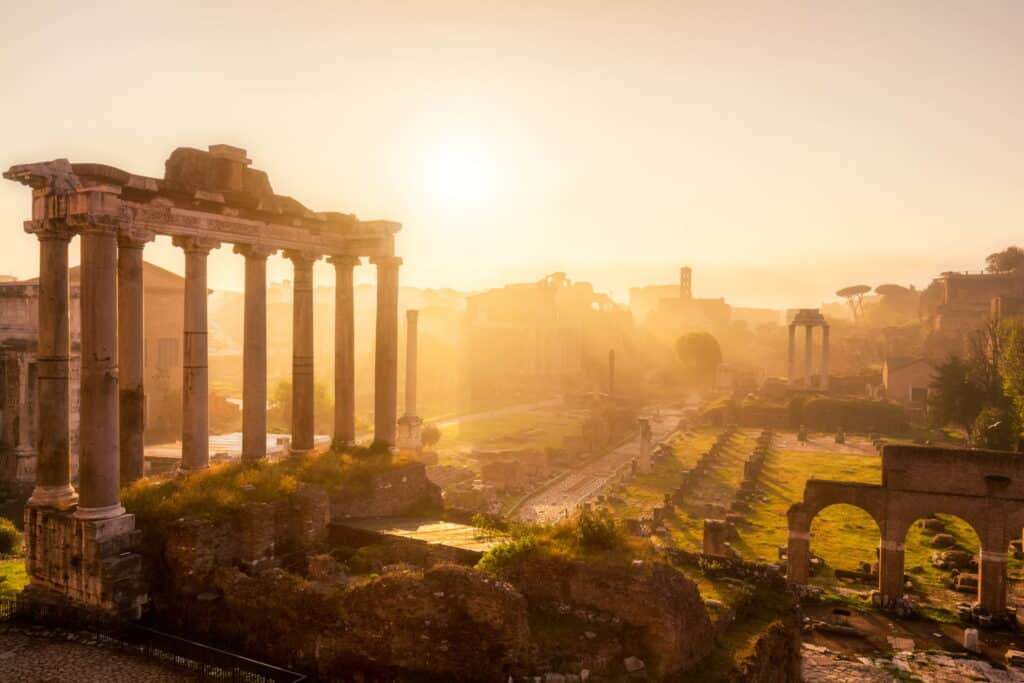
The entrance fee for the Roman Forum is 18€ for the year 2025. A single ticket is sold for the entrance to the Roman Forum, the Colosseum and the Palatine Hill; separate tickets are not sold. In other words, you must purchase a Colosseum ticket or tour to enter the Roman Forum. You can buy a Colosseum ticket to visit the Roman Forum, or you can choose one of the many tour options and visit it with a professional tour guide.
No other site in Europe is so pregnant with history as the Roman Forum. Although the surviving remains give only a very inadequate impression of the splendour of the Forum in ancient times, this area at the foot of the Capitol and the Palatine Hill, with its columns still standing erect or lying tumbled on the ground, its triumphal arches and its remains of walls, still has the power to impress, for it was here during many centuries that the fate of Europe was decided. For more than a thousand years the might of Rome, the magnificence of Roman art, Roman law and Roman religion found imposing and enduring expression here.
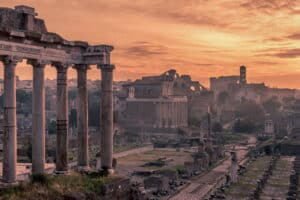
Roman Forum, Rome, Italy
The history of the Roman Forum was, over this long period, the history of Rome and of the western world. Originally a marshy area between the hills of Rome, it was later drained. The first buildings erected here were temples, soon followed by various publicbuildings, and the area becamethe political centre of the city, the meeting -place of the Roman courts and the assemblies which took decisions on the internal and external affairs of the republic. This in turn led to the building of market halls in which the citizens of Rome could go about their business.
The Roman Forum thus developed into a complex of buildings serving the purposes of Rome’s religious, political and commercial life, increasing in splendour as the city grew in power. Consuls and senators, Caesar and later the Emperors vied with one another in developing and embellishing this focal point of the Roman world which became the meeting-place of the peoples of Europe and the Empire. By the end of the Imperial period the Roman Forum was a densely built-up complex in which “modern” buildings rubbed shoulders with ancient ones, carefully planned structures with casually sited later buildings. Not surprisingly, it is sometimes difficult to identify individual buildings in the huddle of the surviving remains.
The last monument erected in ancient times was the undecorated column set up in AD. 608 for the Byzantine Emperor Phocas. Thereafter the buildings fell into ruin, and the Forum began to be used for other purposes. Churches and fortresses were built amid the ancient remains, and the area served as.a quarry of building stone and a pasturage for cows, becoming known as the Campo Vaccino. It was not until the 18th and 19th c. that systematic excavations brought the ancient buildings to light under a layer of earth and rubble between 1 and 15 m deep. It needs a good deal of imagination (and small-scale plaster models) to summon up a picture of the Forum in Imperial times; but the site, even in its state of ruin, still retains a powerful evocative force.
The following are among the most notable features of the site.
Temple of Antoninus and Faustina
From the Via Sacra (Sacred Way) a broad flight of steps leads up to the temple of Antoninus Pius and his wife Faustina. The temple was built by resolution of the Senate in AD. 141 in honour of the deified Empress, and was also dedicated to Antoninus after his death. This is recorded in the inscription, “Divo Antonino et Divae Faustinae ex S(enatus) C(onsulto)”. Of the temple there survive six columns with Corinthian capitals along the front and a number of columns along the side.
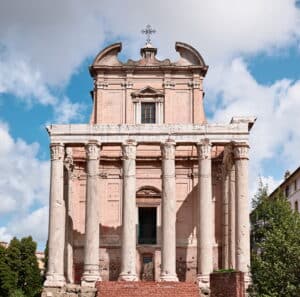
Temple of Antoninus and Faustina
In the 12th c. the temple was converted into the church of San Lorenzo in Miranda. On the occasion of the Emperor Charles V’s visit to Rome in 1536 the columns were disengaged from the medieval masonry.
Temple of Castor and Pollux
The Dioscuri -Castorand Pollux -are the subject of numerous myths, partly of Greek and partly of Etruscan origin, featuring healings (in association with the god Aesculapius), beautiful women (including Helen of Troy) and horsemen with their horses. The first temple of Castor and Pollux was built in 484 B.C. by the son of the dictator Aulus Postumius in thanksgiving for the defeat of the Tarquins, which was attributed to the help of the Dioscuri. According to legend, after the victory Castor and Pollux rode to Rome and watered their horses at a spring in the Forum, the Lacus Juturnae (the position of which has been located).
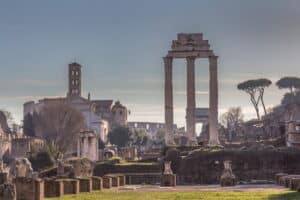
Temple of Castor and Pollux
The temple was rebuilt in the reign of Tiberius (1 st c. AD), and of this temple there survive three Corinthian columns 12 m. high, popularly known as the “Three Sisters”.
Temple of Saturn
The first temple in the Roman Forum was dedicated to Saturn, a god who was probably of Etruscan origin but was adopted by the Romans and worshipped as the supreme god. Built about 497 B.C., soon after the expulsion of the Tarquins, the temple was one of the most important and most venerated of republican Rome.
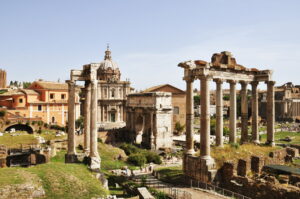
Temple of Saturn
It was several times destroyed by fire (the last occasion being in the 4th c. A.D.) but was repeatedly rebuilt. It is represented by eight columns with Ionic capitals, now much weathered. Under the Republic the state treasury was kept in this temple. The celebration of the Saturnalia, observed annually on 17 December, started from the Temple of Saturn.
Arch of Septimius Severus
It was a regular practice for the Senate and people of Rome to set up triumphal arches in honour of victorious Emperors and generals, and in AD. 203 this arch, opposite the church of Santi Martina e Luca, was erected in honour of Septimius Severus and his sons Caracalla and Geta after their victories over the Parthians and various desert tribes.
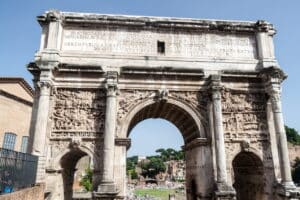
Arch of Septimius Severus at the Roman Forum, Rome, Italy
On the arch, 23 m high and 25 m wide, are four marble reliefs with vigorous representations of episodes from these wars, the figures standing out prominently from the background. Goddesses of victory with trophies and a large inscription proclaim the glory of the Emperor and his sons (though the name of Geta was later erased). Other features of interest adjoining the arch are: The base of a column commemorating the tenth anniversary of Diocletian’s accession. The remains of the Rostra, the ancient orators’ platform, which was originally decorated with the prows (rostra) of captured enemy ships. The position of the Umbilicus Urbis, the “navel” or symbolic centre of Rome.
Curia
The Curia, meeting-place of the Roman Senate, is one of the best preserved ancient buildings in the Roman Forum. The first such building was erected in the time of the kings, and thereafter rebuilding was frequently necessary, as a result of fires and other forms of destruction in the time of Sulla, Caesar, Augustus, Diocletian, Julian the Apostate, etc. Finally in the 7th c. the Curia was converted into a church and was thus preserved from further destruction. Borromini adapted its bronze doors to serve as the main doorway of St John Lateran.
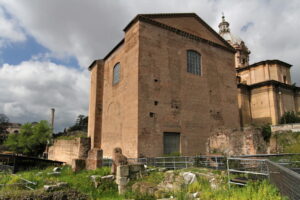
Curia
The Curia, a plain and unornamented building both externally and internally, was stripped of later accretions between 1931 and 1937. It is now sometimes used for special exhibitions. The building measures 27 by 1 8 m (90 by 60 ft) internally, and could seat some 300 senators. It preserves fragments of a coloured marble floor. Here, too, are displayed the Anaglyphs of Trajan, two travertine slabs with reliefs depicting the Emperor and the people of Rome.
Temple of Vesta
In ancient times the Temple of Vesta in the Roman Forum – there is another temple of Vesta in the Forum Boarium – contained the “Sacred Fire” which was guarded by the Vestals (virgins selected from the best families in Rome). The six priestesses served in the temple between the ages of 10 and 14.
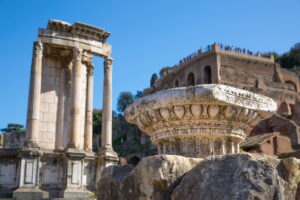
Temple of Vesta
The Romans attached great importance to this “eternal fire”: on the first day of the new year (1 March) they put out the fires in their houses and lit new ones from the flame in the temple of Vesta. The present remains, dating from the time of Septimius Severus (AD. 193-211 ), indicate that the temple was circular, with 20 slender columns supporting the roof. Archaeological investigation has established that there was an opening in the centre of the roof to let out the smoke from the sacred flame.
House of the Vestals
Adjoini ig the Temple of Vesta was the house of the Vestal virgins, also built by Septimius Severus. It consisted of a large atrium, the lodgings of the priestesses and various offices. The plan of the building, with remains of the foundations and numerous statue bases, can be readily identified. It is known from the works of Latin writers that the sacred Palladium (an image of Pallas Athene), which Aeneas was said to have brought from Troy to Latium, was preserved in the House of the Vestals.
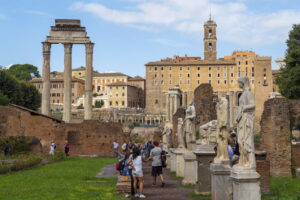
Roman Forum – House of the Vestals
Column of Phocas
In front of the Rostra is a Corinthian column 13-80 m. high, erected in AD. 608 in honour of the Byzantine Emperor Phocas and in recognition of his presentation of the Pantheon to Pope Boniface IV for conversion into a church.
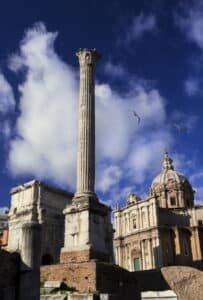
Column of Phocas – Roman Forum
Lapis Niger (Black stone)
Outside the Curia, protected by a low roof, is a block of black marble, under which, according to Roman legend, is the tomb of Romulus founder of Rome. Close by is a stele, excavated in 1899, with the oldest known Latin inscription.
Arch of Titus
At the end of the Roman Forum farthest from the Capitol is the Arch of Titus, the oldest of the Roman triumphal arches, erected after Titus’ death by his successor Domitian. Titus, son of the Emperor Vespasian, was the Roman general who captured Jerusalem in the year 70 and thus put the final seal on the defeat of the Jewish people in Palestine.
Arch of Titus – Roman Forum
The reliefs on the arch, which has a single passageway, depict this event, and also the victorious general’s triumphal procession to the Capitol. Titus (who became Emperor only in the year 79) is shown in his chariot accompanied by the goddess of Victory with a laurel wreath and by the booty brought back from the Jewish War – the seven-branched candlestick, the table with the shewbread and trumpets from the treasury of the Temple.
Santa Maria Antiqua Church
As its name indicates, the church of Santa Maria Antiqua (badly damaged and rarely open to the public) is the oldest and the most important Christian building in the Roman Forum. Converted from a building of the Roman Imperial period in the 6th c. and richly furnished by various 8th c. Popes (John VII, Zacharias and Paul I), the church thereafter fell into a state of dilapidation, before being restored in the 13th c. This extensive complex at the foot of the Palatine hill is of interest for its architecture and for its wall paintings, ranging in date between the 6th and 8th c AD.
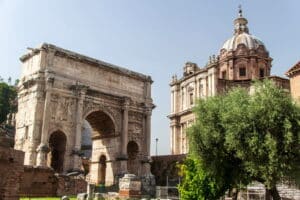
Arch of Septimius Severus and Santa Maria Antiqua Church.

